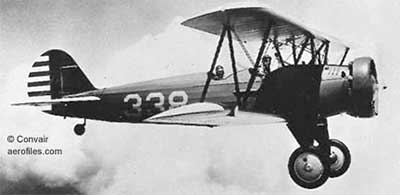OTHER RESOURCES
A very readable volume about the Grand Central Air Terminal is this book:
Underwood, John. 1984. Madcaps, Millionaires and 'Mose'. Heritage Press, Glendale, CA. 144pp.
---o0o---
THANK YOU!
YOUR PURCHASE OF THESE BOOKS SUPPORTS THE WEB SITES THAT BRING TO YOU THE HISTORY BEHIND OLD AIRFIELD REGISTERS
Your copy of the Davis-Monthan Airfield Register (available in paperback) with all the pilots' signatures and helpful cross-references to pilots and their aircraft is available at the link. 375 pages with black & white photographs and extensive tables
---o0o---
The Congress of Ghosts (available as Kindle Edition eBook) is an anniversary celebration for 2010. It is an historical biography, that celebrates the 5th year online of www.dmairfield.org and the 10th year of effort on the project dedicated to analyze and exhibit the history embodied in the Register of the Davis-Monthan Airfield, Tucson, AZ. This book includes over thirty people, aircraft and events that swirled through Tucson between 1925 and 1936. It includes across 277 pages previously unpublished photographs and texts, and facsimiles of personal letters, diaries and military orders. Order your copy at the link.
---o0o---
Military Aircraft of the Davis Monthan Register, 1925-1936 (available in paperback) at the link. This book describes and illustrates with black & white photographs the majority of military aircraft that landed at the Davis-Monthan Airfield between 1925 and 1936. The book includes biographies of some of the pilots who flew the aircraft to Tucson as well as extensive listings of all the pilots and airplanes. Use this FORM to order a copy signed by the author, while supplies last.
---o0o---
Art Goebel's Own Story (available as free PDF download) by Art Goebel (edited by G.W. Hyatt) is written in language that expands for us his life as a Golden Age aviation entrepreneur, who used his aviation exploits to build a business around his passion. Available as a free download at the link.
---o0o---
Winners' Viewpoints: The Great 1927 Trans-Pacific Dole Race (available as Kindle Edition eBook) is available at the link. This book describes and illustrates with black & white photographs the majority of military aircraft that landed at the Davis-Monthan Airfield between 1925 and 1936. The book includes biographies of some of the pilots who flew the aircraft to Tucson as well as extensive listings of all the pilots and airplanes. Use this FORM to order a copy signed by the author, while supplies last.
---o0o---
Clover Field: The first Century of Aviation in the Golden State (available in paperback & Kindle Edition) With the 100th anniversary in 2017 of the use of Clover Field as a place to land aircraft in Santa Monica, this book celebrates that use by exploring some of the people and aircraft that made the airport great. 281 pages, black & white photographs.
---o0o---
YOU CAN HELP
I'm looking for information and photographs of Mounce and his airplane to include on this page. If you have some you'd like to share, please click this FORM to contact me.
---o0o---
Thanks to Guest Editor Bob Woodling for help researching this page.
---o0o---
SPONSORED LINKS
HELP KEEP THESE WEB SITES ONLINE
FOR YOUR CONVENIENCE
You may NOW donate via PAYPAL by clicking the "Donate" icon below and using your credit card. You may use your card or your PAYPAL account. You are not required to have a PAYPAL account to donate.
When your donation clears the PAYPAL system, a certified receipt from Delta Mike Airfield, Inc. will be emailed to you for your tax purposes.
---o0o---
GORDON EBEN MOUNCE
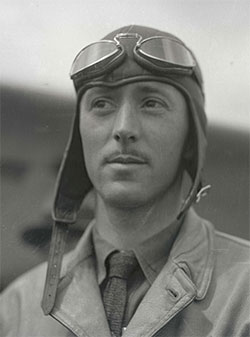 |
Gordon E. Mounce landed twice at the Grand Central Air Terminal (GCAT). Both times he flew the Fleet he identified as NC737V, a Model 7, S/N 302. His first landing was on Sunday, December 14, 1930 at 10:09AM.This airplane was owned by the Fleet Aircraft Company. No other information was recorded for this landing. No home base, destination or number of passengers. His second landing was a week later on Sunday, December 21, 1930 at 1:55PM. This time he identified the owner of the airplane to be himself. Again, no other information was recorded. The photograph of Mounce, right, is from The Oregon Historical Society.
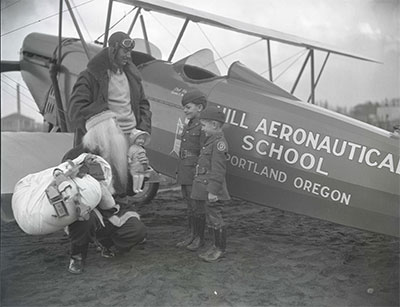 |
From his obituary near the bottom of this page, we learn that, "Gordon Mounce was prominently identified with early development of aviation in Portland. For several years after 1920 he was chief of the Hill Military academy aeronautics school and ended his term in 1929 when he joined the Fleet Aircraft company." The photograph, left, from The Oregon Historical Society, shows Mounce ca. 1920-1929 as chief pilot for Hill. A kneeling Santa Claus offers toys.
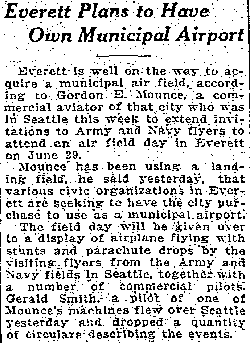 |
A few years earlier, Mounce was cited as the operator at an airport in Everett, WA. An article that appeared in the May 20, 1927 issue of the Seattle Daily TImes, left, cites his work with the Everett Municipal Airport.
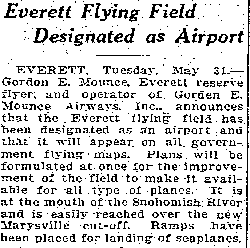 |
Another article in the Seattle Daily Times, right, describes the assignment of the flying field as an officially recognized entity on U.S. government flying charts.
Interestingly, Mounce was an inventor and has at least one patent to his credit. His idea was for an improvement in aerial advertising that involved a towed aerodynamic platform on the bottom of which would be attached electrical signs readable from the ground. His patent application was filed November 25, 1927 and approved September 24, 1928.
His invention was described as in the drawings below. Drawing I represents Mounce's device as towed by a biplane. Note the airfoil cross-section and representation of neon tube letters "B" and "G" in drawing II. The skids on the platform (top of drawing II) were to act during takeoff and landing. It's hard to imagine how the tow airplane would behave if the skids contacted the ground before the airplane wheels. The drag by the platform would dash the airplane to the ground unless the platform and wheels touched down simultaneously.
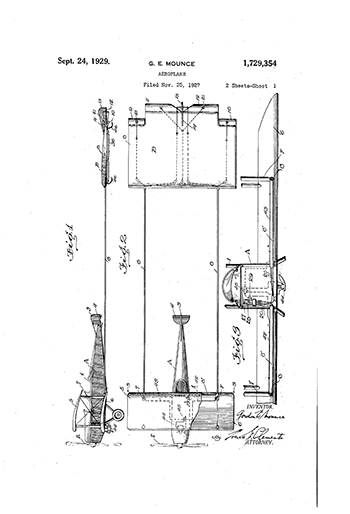 |
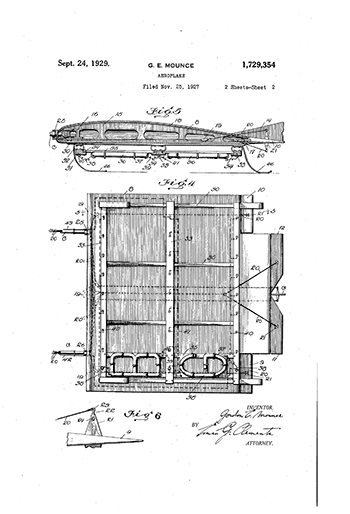 |
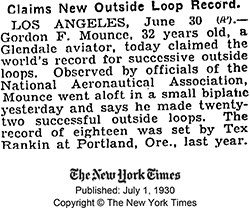 |
Mounce was busy In 1930. The article, right, from The New York Times (NYT), July 1, 1930, describes a record set by Mounce for flying outside loops. An outside loop is performed by flying the airplane in a vertical circle with the top side of the airplane facing away from the center of the circle. Mounce did this successively 22 times, beating the the year-old record of 18 outside loops (some sources say 19) set by Register pilot Tex Rankin.
Nineteen-thirty was a yeasty time for outside loop records. Rankin did his 18 or 19 in January; Mounce performed 22 on July 1st; Dale Jackson of Chicago did 36 on July 6th and, finally, Paul Mantz looped 46 times at San Mateo, CA also on July 6th. These flights were summarized in The New York Times of July 7, 1930. The quest for records for outside loops and other standard aerobatic maneuvers wasn't the only thing going on.
Circa July, 1935, Register pilot Laura Ingalls set a record of 344 consecutive standard loops (top of the airplane faces center of the loop) over Lambert Field, St. Louis. She would go on later in the year to perform 980 loops over Muskogee, OK to better her record. On top of that, on a separate flight, she performed 714 consecutive barrel rolls over St. Louis.
That Mounce flew Fleet aircraft to GCAT is not unexpected, since, according to the information below, he was an employee of the manufacturer (Consolidated Aircraft). The Consolidator, the company news magazine of Consolidated Aircraft, published a brief biography of Mounce in their May, 1938 issue, two months before Mounce's death.
| Gordon E. Mounce was born in Lewiston, Idaho, in May, 1898. Educational training through college. Operated automobile distributorship in conjunction with general garage, also small flying field. U.S. Army Air Corps during war; aerial mapping, advertising and student instruction business for self. Holds Department of Com. Trans. License, F.A.I. license and Airplane and Engine Mechanic's License. Over 5,000 hours of piloting time. Started with Consolidated as West Coast Representative and Demonstration Pilot. Representative for Consolidated in Europe '32 and '35 becoming Assistant to Manager, the position he now holds, in 1935. Finds relaxation in aerial acrobatics and golf. |
There is spotty information about Mounce at ancestry.com. He was born May 28, 1898 at Lewiston, ID. One source identifies his birth date as June 4, 1897, but two other sources cite May. The U.S. Army List of the Officer's Reserve Corps, August 31, 1919, cites his birth date as May 28, 1897.
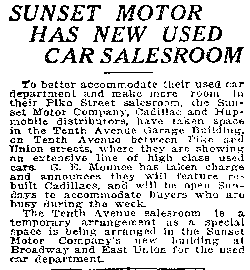 |
Regardless, the 1900 U.S. Census has him living at age three in Lewiston with seven other people in the dwelling, including his father, Ebenezer, his mother, a sister Lionne L. (age 15), a step-sister (age 14) and his mother's father, a physcian (age 79). He also lived with a servant and a lodger. His father was a banker. I could find nothing about him in the 1910 Census.
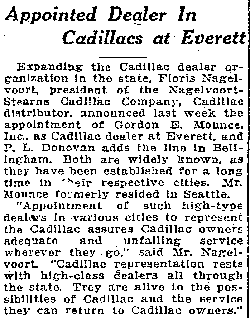 |
A 1920 city directory for Seattle, WA identifies Mounce as the department manager at the Sunset Motorcar Company. He was an early advocacy for aviation near Portland, OR. The auto company might have been his "day job." The Seattle Sunday Times of March 10, 1918 announced a showroom move for Sunset that was managed by Mounce, left. Seven years later, Mounce was named in the Times of May 3, 1925 as head of a new Cadillac dealership in Everett, right.
Further, the 1920 Census cites him (age 23) living in Seattle with Esther Neill Mounce, his wife (age 25). They were married April 4, 1917. The same Census has his parents living with his step-sister and her husband in Seattle. Mounce and Esther had three children (see below). Esther passed away ca. 1925 and, ca. June 28, 1927, he married Lorine Clough (1905-1999) in Everett, WA. The Seattle Times of June 28, 1927 states that the couple eloped after announcing to her mother that they intended to marry. She was 23 years old and he was described by the Times as being 35, which, if he was born in 1897 or 98, was an overestimate. The TImes also stated that he had only two children. Regardless, her parents were said to have opposed the match.
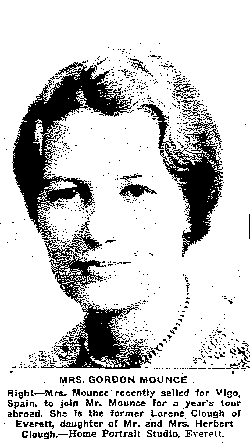 |
 |
Mounce's role as "assistant to the manager" described in the Consolidator biography, above, served him well. He became the European representative for the company and traveled to Europe several times.
Lorine (note her name is spelled "Lorene" in the article at right) accompanied Mounce to Europe in 1932 on behalf of his work with Consolidated Aircraft. An article on the society page of the Seattle Times for May 27, 1932 showed a portrait of the second Mrs. Mounce, right. It is not clear if she sailed at this time, because another article in Times for August 21, 1932, left, cites her departure, on a different date. Perhaps she made two trips; perhaps the May trip was delayed.
She did make the fall trip, however, because a social note in the Times of November 27, 1932 cited the couple in Madrid, Spain. They were soon to leave for a trip through the Balkans. At that time Mounce had been abroad "for several months," and she joined him "in the early fall."
I could find no record in the 1930 Census for Gordon Mounce. However, his parents were living in Port Angeles, WA with a Gordon E. Mounce, age 10 (b. May 19 1919; d. February 1, 1975), identified as their grandson. As well, in the house was Lionne (age 9, b. October 20, 1920; d. May 19, 1999), grandaughter, and Robert Neill Mounce (age 7, b. September 1, 1922; d. June 10, 1994), grandson. It is possible that Mounce and Lorine were in Europe at that time and left their children with his parents. That would also explain his absence from the 1930 Census.
The Seattle Times of May 6, 1934 placed them again in Europe and described a letter in which they talked about, "...their interesting life in Bucharest, Rumania, where she and Mr. Mounce have been making their home for some months. They expected at the time of writing to spend most of the month in Greece." Below, from the Times of October 7, 1934 is an article that includes an excerpt of another one of Mrs. Mounce's letters.
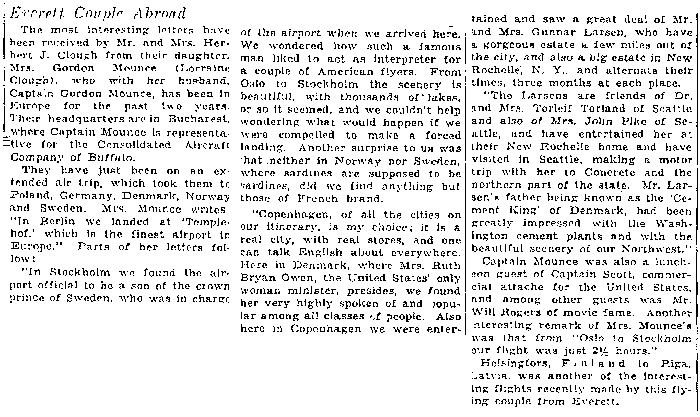 |
There is a record that Mounce and Lorine traveled to Europe again in 1935. There was no mention of their children on the immigration form that cites their departure from LeHavre, France of August 15th and arriving at New York on August 22, 1935. They traveled on the S.S. Washington. The Seattle Times of July 21, 1935 summarized a letter received from the Mounces, viz. they intended to arrive August 22 and travel to Seattle as soon as possible, probably via air, to visit with both their parents. They intended to return to Europe in about two months.
Below, from the Buffalo Courier-Express (NY), August 4, 1934, is a news article describing the award of a medal to Mounce by the Yugoslav government.
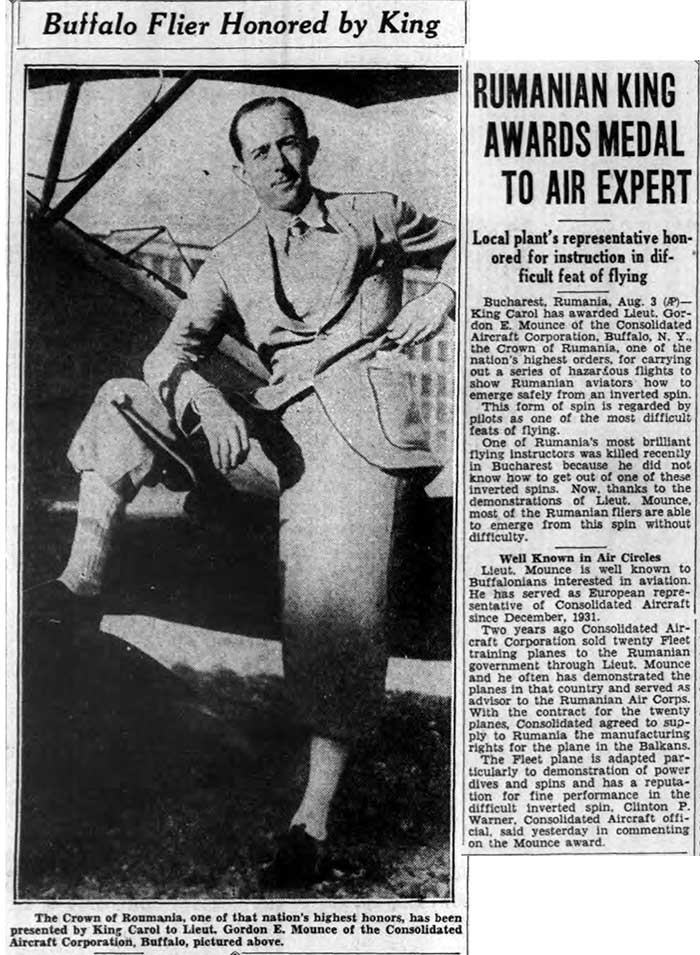 |
The Buffalo Courier-Express (NY) of August 27, 1935, shared by a site visitor, documented their arrival back in the U.S., below. This, and the photo above, are the only photographs I have of Mounce. If you have others you can share, please let me KNOW.
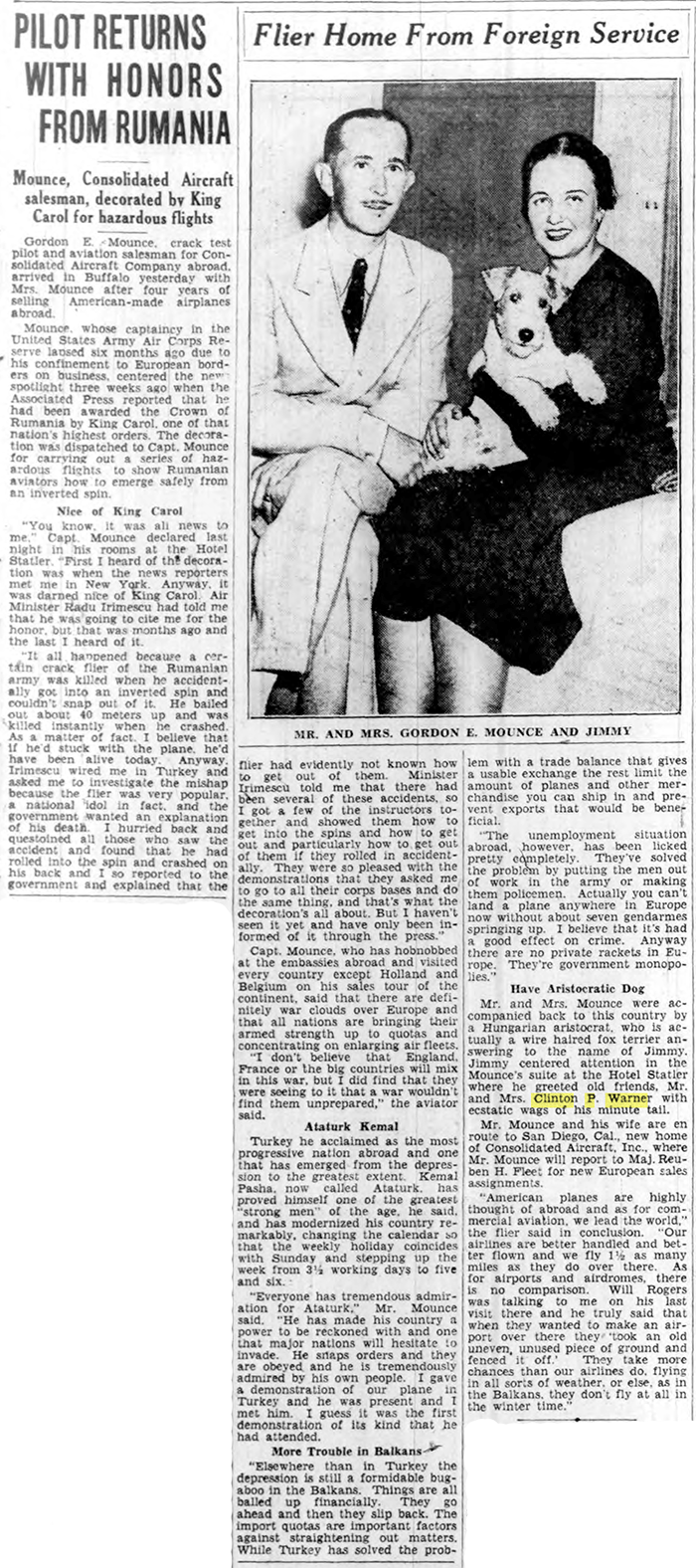 |
The highlighted name, Clinton P. Warner, in the article above leads us to a worthwhile digression, which I have boxed below.
Worthwhile, because it gives us some insight into the nature and reasons for cross-country and international flights during the Golden Age. Because of this Web page, I was contacted by the son of Clinton Warner, who provided information about the friendship and business relationship between Warner and Gordon Mounce in the form of letters from Warner to his wife. Both Warner and Mounce worked for Consolidated in Buffalo, and, together, made two significant flights for the company during the mid-1930s that were described in the letters. The first was an east-west cross-country flight. The trip started in Buffalo, probably on Thursday, November 21 or Friday, November 22 and ended in San Diego on Wednesday, November 27, 1935. A letter from Warner to his wife described it as the most difficult he had ever taken, and it describes many of the hazards the pilots faced. About November 23rd he wrote, "Got as far as St. Elmo, Illinois (80 miles east of St. Louis). Arrived after dark. No hotel so stayed at a private home. The local 'Ladies Aid Society' provided an excellent Thanksgiving Benefit supper for $.35."
Parenthetically, this flight was proceeding in a Fleet Model 21 biplane, an open-cockpit model, named “Esmeralda” by Warner, being sold by Consolidated as a military trainer (example of the type, left, from aerofiles.com). The model 21 (as the militarized PT-11), was used for a sales tour in China, then fitted with a 400HP Pratt & Whitney Wasp Jr. engine for demo flights in Mexico, where it crashed on January 24, 1936. Despite this, the Mexican AF ordered 10, see below. Warner's letter of November 25th read, "We arrived at the O.C. [Oklahoma City] airport before dawn, but poor weather reports prevented our takeoff. At 8AM, Amarillo, Texas reported very bad weather, so we decided to reroute through Wichita Falls, Texas. We took off, and plugged on for 3 hours and 40 minutes until just east of Coahoma, Texas on the way to the good airfield at Big Spring--then the mist had us down right over the highway and railroad. Very judiciously then, after our vision failed to penetrate the misty depths, we did a smart right-about and stood off to survey the prospects. It didn’t look well, so we squatted down on the plain alongside a little service station, from where I got a ride down the road to a telephone at an oil pumping station. .... After waiting an hour during which the easterly wind brought signs of improvement, I hailed a truck that had come through - the driver said the weather there was the same. With the help of a native, we took off, but 3 or 4 miles east of Coahoma, it was worse than before. This time I landed 1 mile east of Coahoma, in a bare field – full of sand burrs, to my sorrow – staked the ship down, covered her up, and stayed overnight. I’m in a little hotel, where there was an elegant “family style” supper-everyone sat at the same table: most of the guests were oil workers who were probably staying at the hotel. It doesn’t appear there’s any chance of reaching San Diego tomorrow." On Tuesday, November 26th, Warner wrote, "This morning we found it had rained terrifically last night, and both tires were flat: Sand Burrs. We borrowed a tire pump & finally got off for a ten minute flight to the airport at Big Spring. There we filled up with gas, oil, and air, and left at 10:30AM CST for El Paso, Texas. We encountered a 40 mile headwind so we landed on the emergency intermediate field at Wink where I had to wait 45 minutes for a gas truck from town [The Charles Cooper Photograph & Document Collection was found at Wink, TX]. Then it took 3 hours and 15 minutes to reach El Paso, the roughest ride I have ever experienced. In Guadalupe Pass, where we had to climb to 6000’ altitude to clear, the ground wind was 72 MPH – right on our nose! Fortunately, visibility was unlimited. More gas and air in El Paso, then off for Lordsburg, New Mexico where we landed just at dusk. A navy officer, Lt. Pixton, got in just ahead of me, so we had supper and a show together. The hotel, “El Hidalgo” is a fine, new modern little place and we had a good night’s rest." The first photograph at this link shows Register pilot T.V. Foster standing in front of the Hidalgo. On November 27th, "The morning dawned clear and beautiful, and we got off early. We landed in Yuma, Arizona after 3 hours and 45 minutes, had a sandwich, a final 20 gallons of gas, and left for San Diego, where we landed at 1:05PM PST. When we got there I found out that we didn’t need to be in San Diego “that early” because the parts for our plane’s repairs were not ready!!!" Their second flight was to Mexico City, December 4, to January 24, 1936. The purpose was to sell Consolidated training airplanes to the Mexican military. On December 20, Warner wrote to his wife, "Things are developing rapidly and we hold our formal demonstration before the Secretary of War – General Figueroa – tomorrow. Gordon will do a little bombing and some aerobatics which I shall make a short vertical dive, 3000 or 4000 feet only. Am expecting Col. Lezama any minute now, so will stop and mail this. Lezama is head of the school, as was Chazaro, but a more capable man." On December 21, 1935 he wrote, "To give you an outline of what happened I’ll start with our arrival. The first thing that took place, of course, was a detailed oral analysis of the ground by Hack following which we went to bat on getting the plane ready for the “pruebas officiales” – official test – during which period we called on innumerable government officials, etc. We outsmarted our competition [Stearman] on one thing immediately – we arranged a hot demonstration of stunting, dive bombing and a T.V. [terminal velocity] dive before the Minister of War and his staff, which went over like a 12-inch mortar [I'd guess that means it was impressive]. I pulled the dive while Gordon did the rest, and a beautiful acrobatics performance it was. The following day we started the official tests which included measurements of takeoff run, landing run, ceiling, rate of climb, low, high, and cruising speed and a cross country run against time to Pachuca and back which I made in 40½ minutes exactly, Things looked pretty well about this, for we had bested our competition (the Stearman) on every count except high speed, and there was little difference in that. Then the undercover work started against us. We were lied about, maligned and attacked on every possible front by the enemy. And to make a long and sorry story short, we were forced to go through the tests again in open, direct competition with the Stearman. Well, we did – and how! We licked them on every single test except the speed, where we knew they had a slight margin. I expected them to beat us on climb and ceiling also, because they had a controllable pitch prop and a slight speed margin, but we even beat them on that run." His letter of December 28, 1935, "Ole Sweetheart--Well, we done it! That is, mostly. Contract was signed yesterday for 10 planes, and the money was due for transfer today. Incidently, the President gave the order to buy our planes on Xmas. Ain’t that something?" "General Chazaro is head of all Mexican Military Schools, including La Escuela Militars de Aviacion, and I’ve been giving him dual instruction in Esmeralda every morning at 7 o’clock. He’s a gentleman of polish and culture, a sportsman and an all around good egg. The Senora is charming as only a Spanish lady can be. We go to their 'casa' at 2:30 today for lunch, which is really dinner – being the main meal of this day." January 11, 1936, "Chazaro and I are leaving – or planning to – Wednesday for Merida, Yucatan. We should be back in Mexico City the following Sunday and I plan on taking off by airplane, train, boat or oxcart for home as soon after that as possible. Our order for 6 Fleets (this is in addition to the previously completed contract for 10 Consolidateds) should be completed by then." Warner's son emailed, "...on January 24, 1936, Chazaro and my father incurred the fatal crash that killed Chazaro instantly, and caused my father’s death about 3 weeks later. Also, my mother told me that she arrived at the hospital in Mexico City shortly after the crash, and was quite lonely and afraid. Chazaro’s wife comforted and stayed with her the whole time: she taught my mother to knit to keep busy during the empty times." |
End digression. A 1937 San Diego business directory has Mounce living in that city with Lorine. The children were not mentioned. If you have any information to share regarding pilot Mounce or his airplanes, please let me KNOW.
He, or they, must have traveled to Europe again. He died in an aircraft accident in Yugoslavia, July 28, 1938. The information quoted below is from The Oregonian, July 29, 1938. The Seattle Times announced his passing a day earlier, below, right.
| SLAV CRASH KILLS EX-PORTLAND ACE Gordon Mounce Dies Looping Plane at Belgrade BELGRADE, Jugoslavia, July 28 (AP) Gordon Mounce, 38, American test pilot and airplane salesman, crashed to his death today after 24 successful demonstrations in looping his baby "fleet" plane at Belgrade's airport at Zemun. Gordon Mounce was prominently identified with early development of aviation in Portland. For several years after 1920 he was chief of the Hill Military academy aeronautics school and ended his term in 1929 when he joined the Fleet Aircraft company. During the world war he was in the air corps and for a number of years was attached as a reserve pilot to the Pearson field army squadron at Vancouver, Wash. He came to Portland from Lewiston, Iowa, and attended Jefferson high school. Officials of the United Aircraft corporation in New York said Gordon E. Mounce was employed by the Consolidated Aircraft corporation of San Diego. |
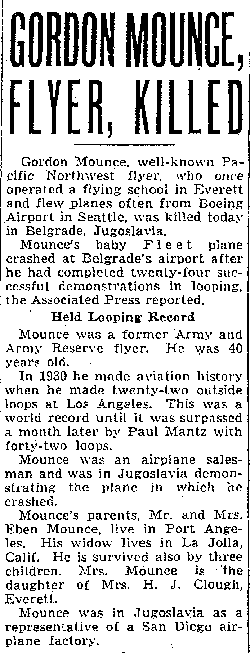 |
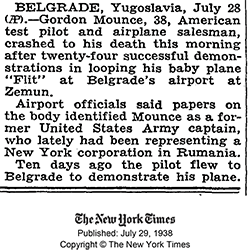 |
Like some other Golden Age pilots, Mounce did not live long enough to achieve a real legacy of accomplishment, a collection of trophies or a file of news clippings.
The fame he had achieved with looping eight years earlier, was, ironically, the activity that caused his death. Another report of Mounce's accident appeared in the NYT of July 28, 1938, left.
Regarding Lorine Mounce, her obituary is below with no mention of children. Mounce's two boys were long dead in 1999. Step-daughter Lionne would pass away 20 days after Lorine.
San Diego Union-Tribune, Friday, May 7, 1999. Deceased Name: LORINE CLOUGH MOUNCE March 31, 1905-April 29, 1999 Lorine Clough Mounce, 94, of Vista died April 29. She was born in Everett, Wash. Mrs. Mounce was retired after working in public relations, and belonged to St. James by the Sea Church in La Jolla. Survivors include her sister, Virginia C. Calloway of San Marcos. Services will be private....
|
---o0o---
SPONSORED LINKS
THIS PAGE UPLOADED: 11/04/15 REVISED: 04/11/16, 05/27/17, 06/29/18

